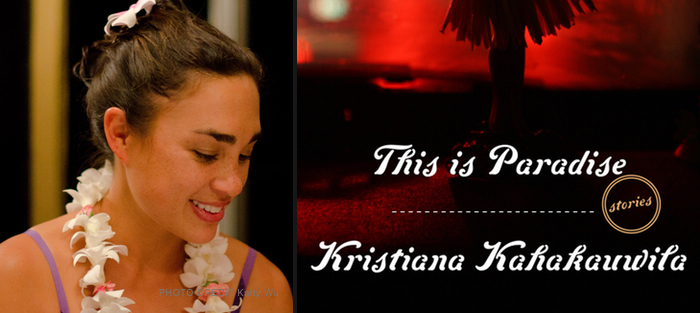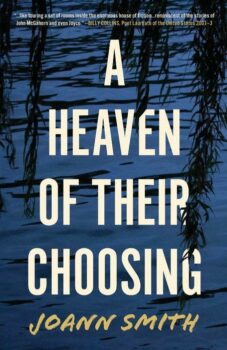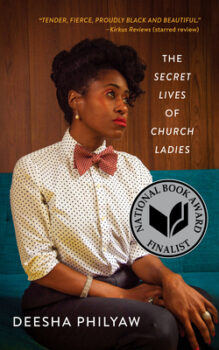The six stories that make up This is Paradise, the debut collection by Kristiana Kahakauwila, published this week by HOGARTH, a Random House imprint, all take place in the Hawaiian Islands. Though contemporary in setting, they feature characters consumed and confronted by ancestry, history, and family. The title story shows the friction between locals and tourists in Waikiki Beach. “Wanle” follows a conflicted cockfighter’s daughter in the Maui highlands, as she struggles with her father’s doubled-edged legend. “The Road to Hana” complicates the very definitions of local and transplant—in Hawai`i and beyond. Stories like “The Old Paniolo Way” don’t shy away from a warts-and-all take on tradition.
All of these short stories are, in fact, long and immersive, ambitious in their scope and lush in their atmosphere, relevant, big-hearted, and intensely readable. Kahakauwila’s greatest talent is her ability to move heavy thematic freight at high velocity. Even her most poignant cultural statements crackle with wry humor, sexual tension, and snappy dialogue.
While united by setting, these stories display a wide array of stylistic approaches. It is one of those rare collections that function even better as a whole than any of the stories could in isolation; it uses the prismatic nature of the form to bring a layered and diverse place to life. With this ensemble cast of tourists, hotel maids, cockfighters, and aging cowboys, Kahakauwila manages to show contemporary Hawai`i in all of its breadth and complexity.
Kristiana Kahakauwila is a graduate of Long Beach Polytechnic High School and Princeton University, where she earned a B.A. in Comparative Literature and Creative Writing. She received an M.F.A. in Creative Writing from the University of Michigan, Ann Arbor, and is currently an Assistant Professor of Creative Writing at Western Washington University.
Interview:
Tyler McMahon: You’ve studied fiction at both the undergraduate and graduate level. Do you feel you learned a lot about the craft in academia? Did your education help prepare you to write this collection?
Kristiana Kahakauwila: I blossomed in the academic setting, and I was fortunate to learn about craft from some of the best living writers. Chase Twitchell and David Trinidad, whose poetry workshops were my first formal courses in creative writing, taught me about the importance of the line and literal meaning. Chase had no patience for overly wrought abstraction. Thank goodness! I was firmly rooted in the adolescent poetry that I had been writing in my journals for years, which was all ideas and no images. She jolted me out of that, and David pushed me to take a fiction class to refine my narrative poetry. I think he thought I’d come back to poetry the next semester, but I quickly realized fiction was where I wanted to be.
Without these early workshops, I wouldn’t have been pushed beyond my comfort zone. I would have continued to write in the same vein, with the same faults.
I’ve always been an avid reader, but I learned how to read as a writer while I was in my M.F.A. Obviously, reading can happen outside of academia, but learning to break down a story and see how it functions, how the parts fit together, was a learned skill for me. Peter Ho Davies’ course on the history of the short story did this for me, and it gave me a great base for understanding where my work fit into a larger arc.
Working with Joyce Carol Oates was also wonderful, as she has very specific exercises to help her students focus on individual craft points: dialogue, conflict, character. I could see, within the course of a single exercise, my writing improve. Now, when I teach creative writing, I use many of those exercises that I first learned in her class.
You mention that you started your formal writing education in poetry. Has that colored how you write, or how you teach?
Absolutely. I am focused on the line both in my own writing and when I teach. Yes, I care deeply about creating complex, real characters. Yes, I want a plot that feels taut and suspenseful. But I can be patient with these other aspects of a story if the language is beautiful. If the language is dull, then why keep reading to find out the plot?
In teaching, I ask my students to focus a lot on revision. And while I know that I probably shouldn’t give them too much to revise at once—for fear of overwhelming or confusing them—I can’t help but line-edit their work, even their first drafts. But in these line-edits, these requests for sharper word choice or more concision, is also a request for better logic, more original thinking. So I think that asking for poetry in prose—and teaching it beside prose—is a sure way to improve fiction.
Hawai`i is a place that that’s been represented and misrepresented in so many texts. What do you think it’s important to draw attention to? Were there particular stereotypes or misconceptions that you wanted to set straight?
 In popular fiction Hawai`i has often been described from the perspective of visitors. When I was working on this book, everyone wanted to know if I had read James Michener and Robert Louis Stevenson. I hadn’t at the time; I didn’t want to use their perspectives, which are plenty prevalent. I was interested in learning Native and local narratives, from the writings of Haunani Kay-Trask to the stories my uncles and aunties tell.
In popular fiction Hawai`i has often been described from the perspective of visitors. When I was working on this book, everyone wanted to know if I had read James Michener and Robert Louis Stevenson. I hadn’t at the time; I didn’t want to use their perspectives, which are plenty prevalent. I was interested in learning Native and local narratives, from the writings of Haunani Kay-Trask to the stories my uncles and aunties tell.
So, I set out to reverse “the gaze” and have this book value Native’s and locals’ visions of the islands rather than visitors’. The title story deals with this pretty explicitly. I also wanted to draw attention to the fact that even among locals and Natives, not everyone sees the islands the same. Stories like “The Road to Hana” engage pretty directly with that fact.
I was also playing with a lot of common, commercial stereotypes. Hawaiian women as sexual flowers for the taking, like the postcard image of the hula girl. Hawaiian men as either wild, angry animals or playboys. If you look at advertisements from the past century, even in today’s era, these are the sorts of images that sell Hawai`i and its people. I wanted to take these images and very purposefully undermine them. The women in my story are sexual and strong; the men are powerful and compassionate. In other words, they’re fully human.
Are there any fiction writers who influenced these stories? From Hawai`i or elsewhere?
Although not fiction writers, David Malo, Samuel Kamakau, Kepelino, and the other Hawaiians who first commited oral narrative to written text are endlessly fascinating to me. These writers are navigating the gaping cultural divide of the early to mid 1800s, and while they record traditions, they also heavily editorialize the record, sometimes apologizing for a native tradition and other times defending it. Through their writings, you can feel them being torn between their native-ness and the new, settler culture, which is primarily a white, Christian, American culture. I felt those writers’ position is still relevant today, and the way they express being betwixt and between—a feeling I know personally as well—was essential to the development of my work. In some ways, “Thirty-Nine Rules” is a response to this fraught position, but the ideas those writers engender linger elsewhere in the collection.
Do you think that being Hawaiian but having grown up on the mainland lends you any advantage, as an author? Would if be harder or easier to write about Hawai`i if you had lived here all your life?
I’ll answer this question with a story. I have a friend who learned to surf in California. When she was out visiting me in Hawai`i, she’d drop in on people and a couple times cut someone off. I thought, at the time, she’s one of the nicest, most polite people I know. Why is she doing this on the water?
Then, I went to surf with her in Malibu. To me, it was mayhem! Everyone’s dropping in on everyone else. There’s no clear line-up. And I realized, oh, kids who come from California to surf in Hawai`i aren’t purposely being rude. They just aren’t aware of the rules here, how Hawai`i surf community works.
The fact that I’m hapa—half Hawaiian, half European ancestry—means that I inhabit more than one culture. Similarly, I inhabit more than one geographical space: I grew up in Southern California, but spent summers and holidays on Maui. I do feel that hapa-ness, that ability to be betwixt and between, is what allowed me to write this book. I can feel empathy for a lot of different perspectives and see the value in each of them.
Going back to my story about surfing, I also understand someone who wants to do what’s right but isn’t sure what that is. I felt like that a lot during my first few years living in Hawai`i as an adult. I had to come back to my Hawaiian-ness, and I had to be very humble and learn from the community around me. I couldn’t have written this book if I hadn’t grown up on the Mainland, but I also couldn’t have written it if I hadn’t lived in Hawai`i.
Which of these stories was most difficult to write?
“The Road to Hana” was probably the most difficult. The other stories are focused on familial relationships, which feel natural for me to explore, but a romantic relationship was much more difficult for me to excavate. Were my characters too explosive? Were they too passive aggressive? Did I favor one more than the other?
It probably didn’t help that I was writing the story with a kernel of truth in it—I actually did once drive that road with an ex-boyfriend, and we did nearly hit a dog, and it did have more fleas than either of us cares to remember. So I had to distance myself from the real incident in order to shape a fictitious one with fictitious but fully rounded characters.
That’s interesting that “The Road to Hana” was the most difficult. In so many ways, that would seem to be the simplest story—in terms of timeline, point-of-view, amount of characters, etc. The other pieces are generally bigger and more epic in their sweep. Do you find that you gravitate toward those longer, multiple point-of-view stories with an ensemble cast?
I am secretly writing novels—very short novels masquerading as stories. I love the messiness of novels, the multiple strands and ensemble cast and movements across time that novels can contain. My short stories tend toward that vein. They’re the most fun for me.
That’s actually one of the most fascinating aspects of this collection: on the one hand, the stories are mostly long and “novelesque.” But in another way, this collection covers more ground than a single long narrative might. Why do you think this form—by which I mean the collection, as opposed to the short story—is so well suited to your subject(s)?
 In the title story and “Portrait of a Good Father,” the narrative is told by more than one person, in more than one perspective. Only by seeing the same events from these multiple perspectives does a physical, intellectual, and emotional truth emerge. To tell the story from one perspective would be to tell a less truthful story.
In the title story and “Portrait of a Good Father,” the narrative is told by more than one person, in more than one perspective. Only by seeing the same events from these multiple perspectives does a physical, intellectual, and emotional truth emerge. To tell the story from one perspective would be to tell a less truthful story.
I say all this because I think the collection is operating in a similar manner. With a collection, unlike with a novel, I can hop among islands, characters, events, and perspectives. I have a writerly freedom in that and an ethical project as well. The most truthful story doesn’t appear from a single objective point of view, as textbooks might have us believe. Truth comes from layering as many points of view together as possible and letting a reader experience them all.
On a side note, as I was writing these stories, I was often asked if any characters reoccur. I thought briefly about linking the stories in that way, but then I realized that would undermine my project. In fact, only one central character appears in all the stories, and that’s Hawai`i. Only a collection such as this one could reflect how I experience Hawai`i’s multitude and diversity.
Can you talk about your process a little? Do you have a regular writing routine? Is it efficient? I’m particularly curious to know how that “messy,” layered streak in your work plays out at the writing desk?
I have a sort of messy process. I don’t write every day. I don’t even write every week. I write in insane focused spurts, these multi-week sprints where bills don’t get paid, friends don’t get called, my mother sends me emails asking if I’m alive. All I do is write and run. Or write, run, and show up for work.
And then I fall behind on the rest of my life and have to play catch-up. So I don’t write for a few weeks while I call my mother and grade my students’ papers and shower.
That said, I’m thinking about writing all the time. While I run, I’m trying to figure out a character’s motivation or how a relationship between two characters will play out. And I read every day—read as a writer every day—before bed or, sometimes, in the morning. And then, when all this thinking and reading has gathered into a critical mass, I create a space to write again.
For me, this process works really well. It operates in tandem with the ebbs and flows of the school year. It gives me this wonderful space for my thoughts to develop. And it also means that I have time to process the research that I do. I don’t want to sound like a history book, so letting the research percolate and then connect with story—letting that happen in the fallow times between actually putting pen to paper—is efficient and enjoyable for me.
What’s your next writing project?
Alas, I’m leaving behind short stories for a little while to write a novel, which is a new sort of adventure. The novel is a multi-generational family saga set against the backdrop of a real water rights dispute between east Maui taro farmers and the A&B sugar plantation. Now that king sugar is no longer king, and pineapple is no longer a cash crop, Maui’s landscape has changed tremendously. I’m exploring what that means to different generations, and how a family who is already beset by personal crisis can overcome community crisis. The two seem linked to me, and I think by finding an answer to the personal, we can find a better path for the communal.
Further Links and Resources:
- For more about Kristiana Kahakauwila and her work, please visit the author’s website.
- You can also visit her Random House author page to read an excerpt from the book, purchase a copy, or check out the reader’s guide for the collection.






